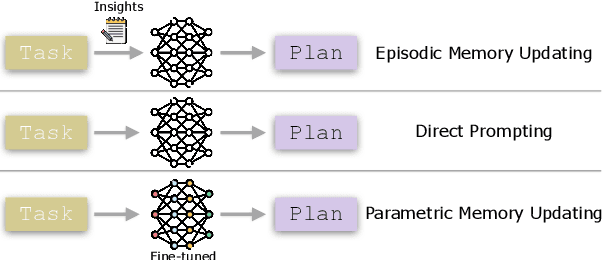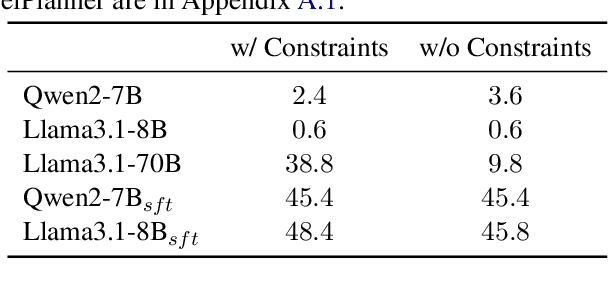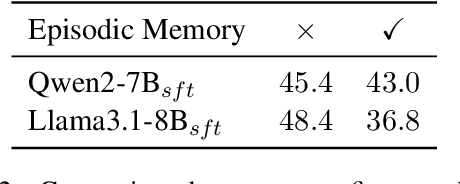Jian Xie
UniEDU: A Unified Language and Vision Assistant for Education Applications
Mar 26, 2025Abstract:Education materials for K-12 students often consist of multiple modalities, such as text and images, posing challenges for models to fully understand nuanced information in these materials. In this paper, we propose a unified language and vision assistant UniEDU designed for various educational applications, including knowledge recommendation, knowledge tracing, time cost prediction, and user answer prediction, all within a single model. Unlike conventional task-specific models, UniEDU offers a unified solution that excels across multiple educational tasks while maintaining strong generalization capabilities. Its adaptability makes it well-suited for real-world deployment in diverse learning environments. Furthermore, UniEDU is optimized for industry-scale deployment by significantly reducing computational overhead-achieving approximately a 300\% increase in efficiency-while maintaining competitive performance with minimal degradation compared to fully fine-tuned models. This work represents a significant step toward creating versatile AI systems tailored to the evolving demands of education.
LLM Agents for Education: Advances and Applications
Mar 14, 2025Abstract:Large Language Model (LLM) agents have demonstrated remarkable capabilities in automating tasks and driving innovation across diverse educational applications. In this survey, we provide a systematic review of state-of-the-art research on LLM agents in education, categorizing them into two broad classes: (1) \emph{Pedagogical Agents}, which focus on automating complex pedagogical tasks to support both teachers and students; and (2) \emph{Domain-Specific Educational Agents}, which are tailored for specialized fields such as science education, language learning, and professional development. We comprehensively examine the technological advancements underlying these LLM agents, including key datasets, benchmarks, and algorithmic frameworks that drive their effectiveness. Furthermore, we discuss critical challenges such as privacy, bias and fairness concerns, hallucination mitigation, and integration with existing educational ecosystems. This survey aims to provide a comprehensive technological overview of LLM agents for education, fostering further research and collaboration to enhance their impact for the greater good of learners and educators alike.
Implicit Reasoning in Transformers is Reasoning through Shortcuts
Mar 10, 2025Abstract:Test-time compute is emerging as a new paradigm for enhancing language models' complex multi-step reasoning capabilities, as demonstrated by the success of OpenAI's o1 and o3, as well as DeepSeek's R1. Compared to explicit reasoning in test-time compute, implicit reasoning is more inference-efficient, requiring fewer generated tokens. However, why does the advanced reasoning capability fail to emerge in the implicit reasoning style? In this work, we train GPT-2 from scratch on a curated multi-step mathematical reasoning dataset and conduct analytical experiments to investigate how language models perform implicit reasoning in multi-step tasks. Our findings reveal: 1) Language models can perform step-by-step reasoning and achieve high accuracy in both in-domain and out-of-domain tests via implicit reasoning. However, this capability only emerges when trained on fixed-pattern data. 2) Conversely, implicit reasoning abilities emerging from training on unfixed-pattern data tend to overfit a specific pattern and fail to generalize further. Notably, this limitation is also observed in state-of-the-art large language models. These findings suggest that language models acquire implicit reasoning through shortcut learning, enabling strong performance on tasks with similar patterns while lacking generalization.
Exploring the Inquiry-Diagnosis Relationship with Advanced Patient Simulators
Jan 16, 2025Abstract:Online medical consultation (OMC) restricts doctors to gathering patient information solely through inquiries, making the already complex sequential decision-making process of diagnosis even more challenging. Recently, the rapid advancement of large language models has demonstrated a significant potential to transform OMC. However, most studies have primarily focused on improving diagnostic accuracy under conditions of relatively sufficient information, while paying limited attention to the "inquiry" phase of the consultation process. This lack of focus has left the relationship between "inquiry" and "diagnosis" insufficiently explored. In this paper, we first extract real patient interaction strategies from authentic doctor-patient conversations and use these strategies to guide the training of a patient simulator that closely mirrors real-world behavior. By inputting medical records into our patient simulator to simulate patient responses, we conduct extensive experiments to explore the relationship between "inquiry" and "diagnosis" in the consultation process. Experimental results demonstrate that inquiry and diagnosis adhere to the Liebig's law: poor inquiry quality limits the effectiveness of diagnosis, regardless of diagnostic capability, and vice versa. Furthermore, the experiments reveal significant differences in the inquiry performance of various models. To investigate this phenomenon, we categorize the inquiry process into four types: (1) chief complaint inquiry; (2) specification of known symptoms; (3) inquiry about accompanying symptoms; and (4) gathering family or medical history. We analyze the distribution of inquiries across the four types for different models to explore the reasons behind their significant performance differences. We plan to open-source the weights and related code of our patient simulator at https://github.com/LIO-H-ZEN/PatientSimulator.
Baichuan4-Finance Technical Report
Dec 17, 2024Abstract:Large language models (LLMs) have demonstrated strong capabilities in language understanding, generation, and reasoning, yet their potential in finance remains underexplored due to the complexity and specialization of financial knowledge. In this work, we report the development of the Baichuan4-Finance series, including a comprehensive suite of foundational Baichuan4-Finance-Base and an aligned language model Baichuan4-Finance, which are built upon Baichuan4-Turbo base model and tailored for finance domain. Firstly, we have dedicated significant effort to building a detailed pipeline for improving data quality. Moreover, in the continual pre-training phase, we propose a novel domain self-constraint training strategy, which enables Baichuan4-Finance-Base to acquire financial knowledge without losing general capabilities. After Supervised Fine-tuning and Reinforcement Learning from Human Feedback and AI Feedback, the chat model Baichuan4-Finance is able to tackle various financial certification questions and real-world scenario applications. We evaluate Baichuan4-Finance on many widely used general datasets and two holistic financial benchmarks. The evaluation results show that Baichuan4-Finance-Base surpasses almost all competitive baselines on financial tasks by significant margins without sacrificing performance on general LLM benchmarks. At the same time, Baichuan4-Finance demonstrates even more impressive performance on financial application scenarios, showcasing its potential to foster community innovation in the financial LLM field.
Technical Report: Enhancing LLM Reasoning with Reward-guided Tree Search
Nov 18, 2024



Abstract:Recently, test-time scaling has garnered significant attention from the research community, largely due to the substantial advancements of the o1 model released by OpenAI. By allocating more computational resources during the inference phase, large language models~(LLMs) can extensively explore the solution space by generating more thought tokens or diverse solutions, thereby producing more accurate responses. However, developing an o1-like reasoning approach is challenging, and researchers have been making various attempts to advance this open area of research. In this paper, we present a preliminary exploration into enhancing the reasoning abilities of LLMs through reward-guided tree search algorithms. This framework is implemented by integrating the policy model, reward model, and search algorithm. It is primarily constructed around a tree search algorithm, where the policy model navigates a dynamically expanding tree guided by a specially trained reward model. We thoroughly explore various design considerations necessary for implementing this framework and provide a detailed report of the technical aspects. To assess the effectiveness of our approach, we focus on mathematical reasoning tasks and conduct extensive evaluations on four challenging datasets, significantly enhancing the reasoning abilities of LLMs.
AAAR-1.0: Assessing AI's Potential to Assist Research
Oct 29, 2024Abstract:Numerous studies have assessed the proficiency of AI systems, particularly large language models (LLMs), in facilitating everyday tasks such as email writing, question answering, and creative content generation. However, researchers face unique challenges and opportunities in leveraging LLMs for their own work, such as brainstorming research ideas, designing experiments, and writing or reviewing papers. In this study, we introduce AAAR-1.0, a benchmark dataset designed to evaluate LLM performance in three fundamental, expertise-intensive research tasks: (i) EquationInference, assessing the correctness of equations based on the contextual information in paper submissions; (ii) ExperimentDesign, designing experiments to validate research ideas and solutions; (iii) PaperWeakness, identifying weaknesses in paper submissions; and (iv) REVIEWCRITIQUE, identifying each segment in human reviews is deficient or not. AAAR-1.0 differs from prior benchmarks in two key ways: first, it is explicitly research-oriented, with tasks requiring deep domain expertise; second, it is researcher-oriented, mirroring the primary activities that researchers engage in on a daily basis. An evaluation of both open-source and proprietary LLMs reveals their potential as well as limitations in conducting sophisticated research tasks. We will keep iterating AAAR-1.0 to new versions.
Revealing the Barriers of Language Agents in Planning
Oct 16, 2024



Abstract:Autonomous planning has been an ongoing pursuit since the inception of artificial intelligence. Based on curated problem solvers, early planning agents could deliver precise solutions for specific tasks but lacked generalization. The emergence of large language models (LLMs) and their powerful reasoning capabilities has reignited interest in autonomous planning by automatically generating reasonable solutions for given tasks. However, prior research and our experiments show that current language agents still lack human-level planning abilities. Even the state-of-the-art reasoning model, OpenAI o1, achieves only 15.6% on one of the complex real-world planning benchmarks. This highlights a critical question: What hinders language agents from achieving human-level planning? Although existing studies have highlighted weak performance in agent planning, the deeper underlying issues and the mechanisms and limitations of the strategies proposed to address them remain insufficiently understood. In this work, we apply the feature attribution study and identify two key factors that hinder agent planning: the limited role of constraints and the diminishing influence of questions. We also find that although current strategies help mitigate these challenges, they do not fully resolve them, indicating that agents still have a long way to go before reaching human-level intelligence.
Boosting Deductive Reasoning with Step Signals In RLHF
Oct 12, 2024Abstract:Logical reasoning is a crucial task for Large Language Models (LLMs), enabling them to tackle complex problems. Among reasoning tasks, multi-step reasoning poses a particular challenge. Grounded in the theory of formal logic, we have developed an automated method, Multi-step Deduction (MuseD), for deductive reasoning data. MuseD has allowed us to create training and testing datasets for multi-step reasoning. Our generation method enables control over the complexity of the generated instructions, facilitating training and evaluation of models across different difficulty levels. Through RLHF training, our training data has demonstrated significant improvements in logical capabilities for both in-domain of out-of-domain reasoning tasks. Additionally, we have conducted tests to assess the multi-step reasoning abilities of various models.
Uncertainty-aware Reward Model: Teaching Reward Models to Know What is Unknown
Oct 01, 2024Abstract:Reward models (RM) play a critical role in aligning generations of large language models (LLM) to human expectations. However, prevailing RMs fail to capture the stochasticity within human preferences and cannot effectively evaluate the reliability of reward predictions. To address these issues, we propose Uncertain-aware RM (URM) and Uncertain-aware RM Ensemble (URME) to incorporate and manage uncertainty in reward modeling. URM can model the distribution of disentangled attributes within human preferences, while URME quantifies uncertainty through discrepancies in the ensemble, thereby identifying potential lack of knowledge during reward evaluation. Experiment results indicate that the proposed URM achieves state-of-the-art performance compared to models with the same size, demonstrating the effectiveness of modeling uncertainty within human preferences. Furthermore, empirical results show that through uncertainty quantification, URM and URME can identify unreliable predictions to improve the quality of reward evaluations.
 Add to Chrome
Add to Chrome Add to Firefox
Add to Firefox Add to Edge
Add to Edge